Charles E W Bean, Diaries, AWM38 3DRL 606/244/1 - 1916 - 1933 - Part 7
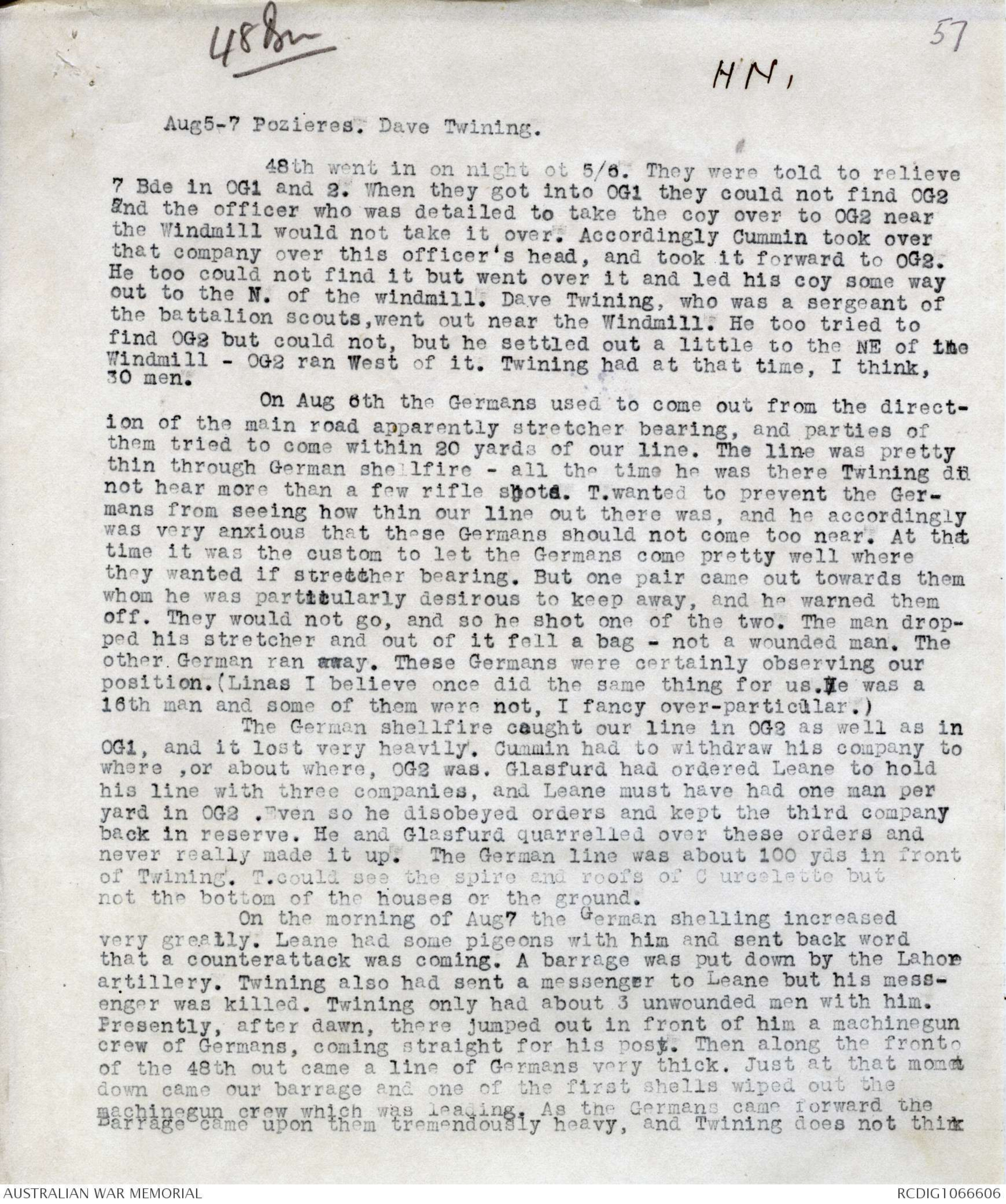
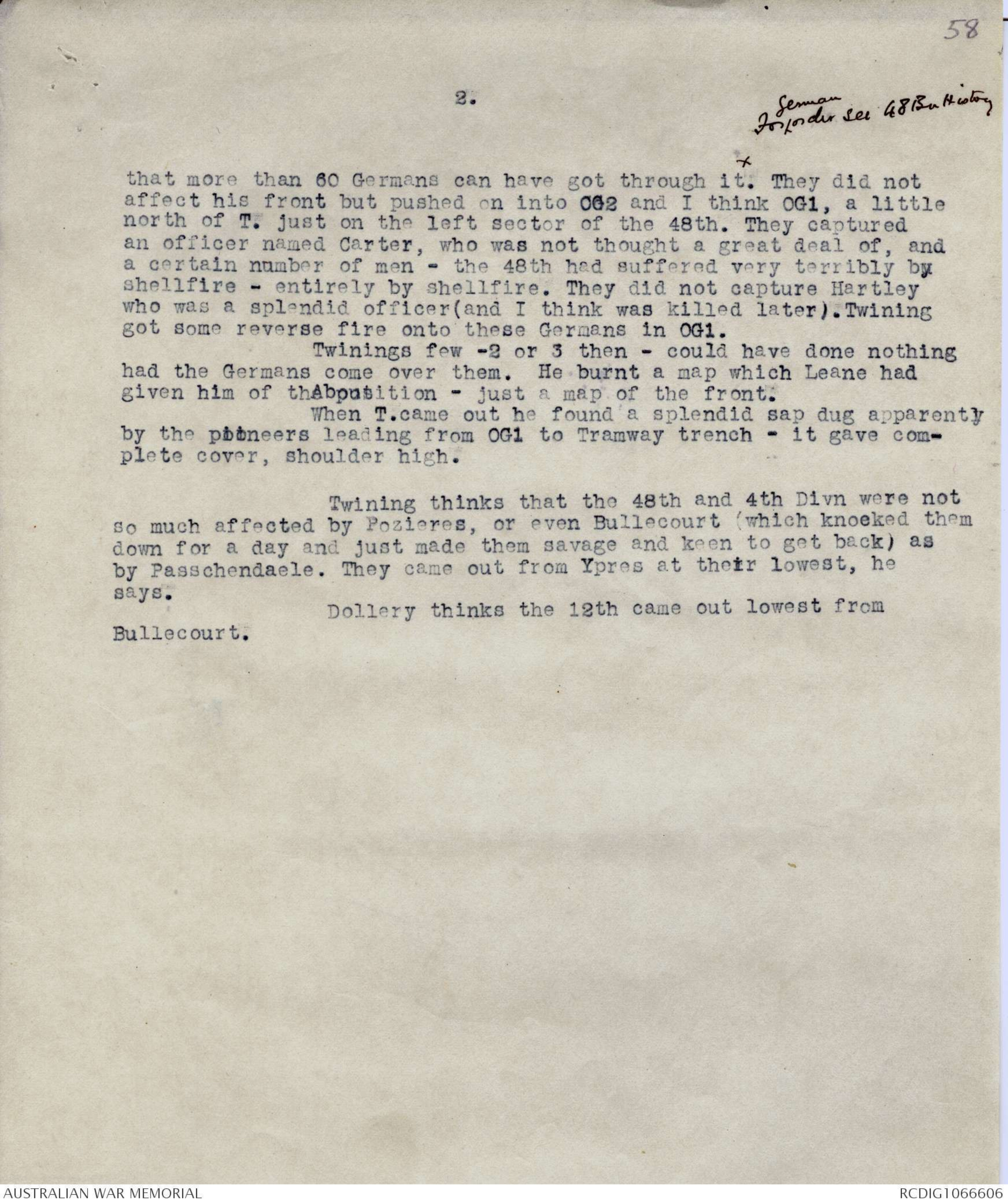

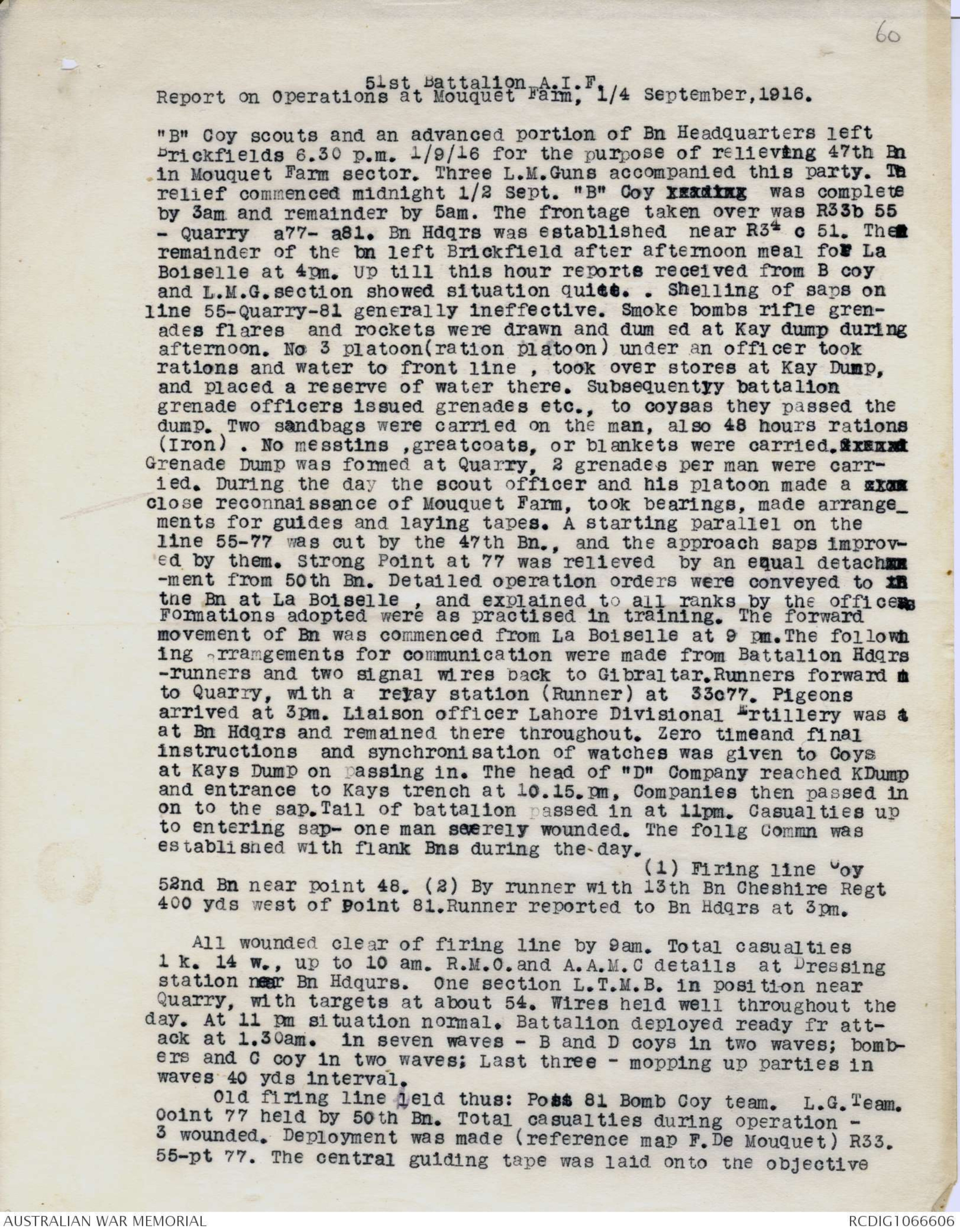
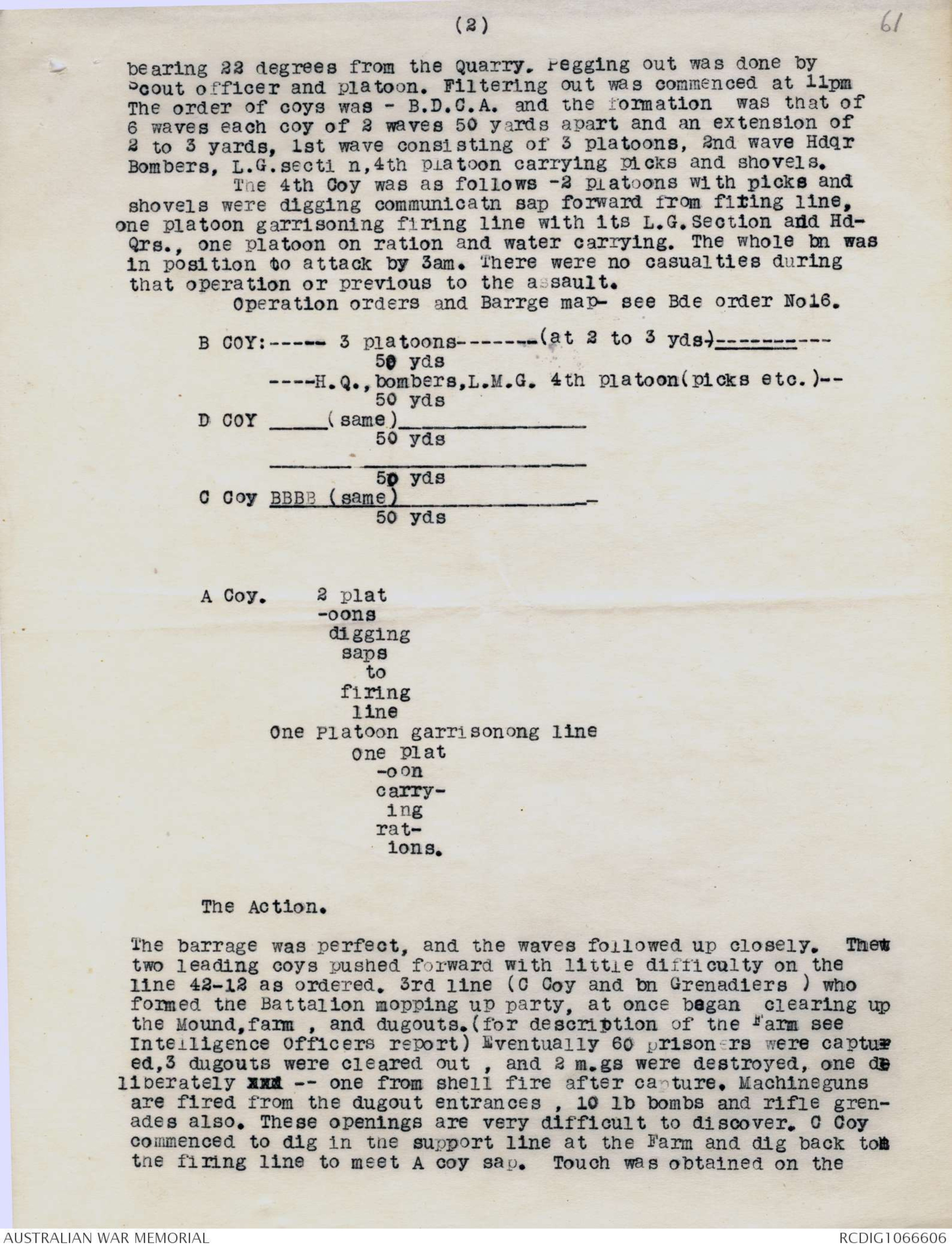
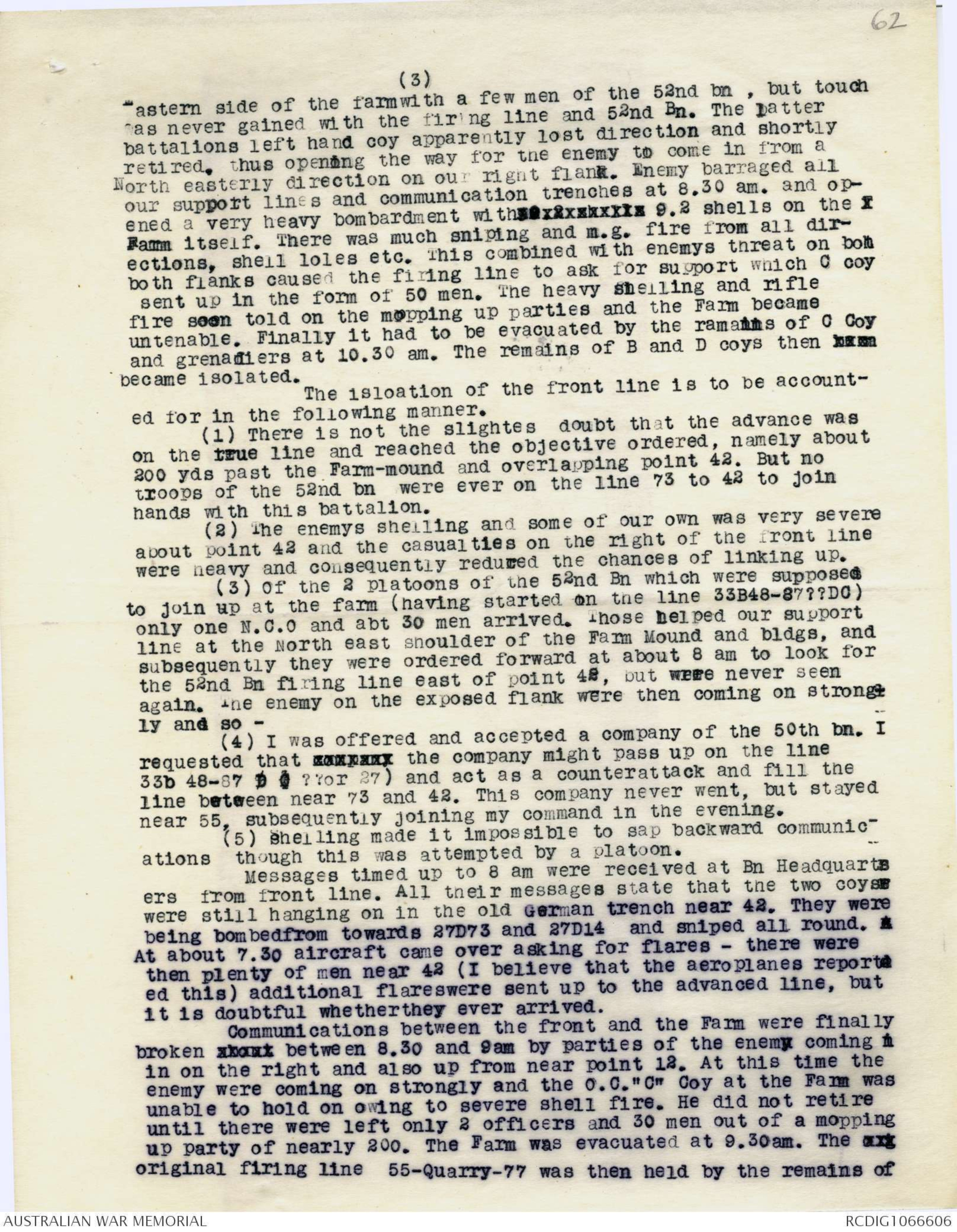
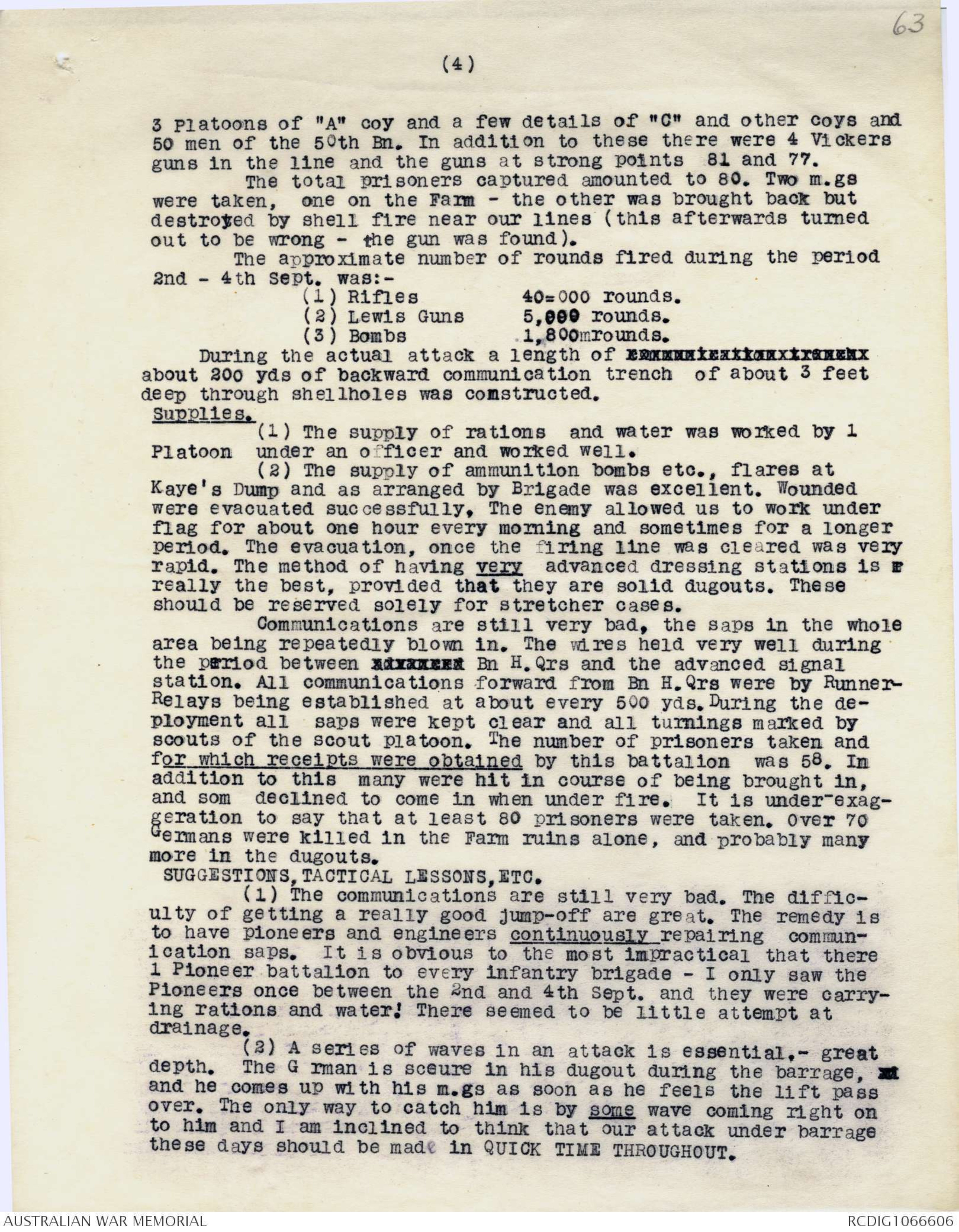
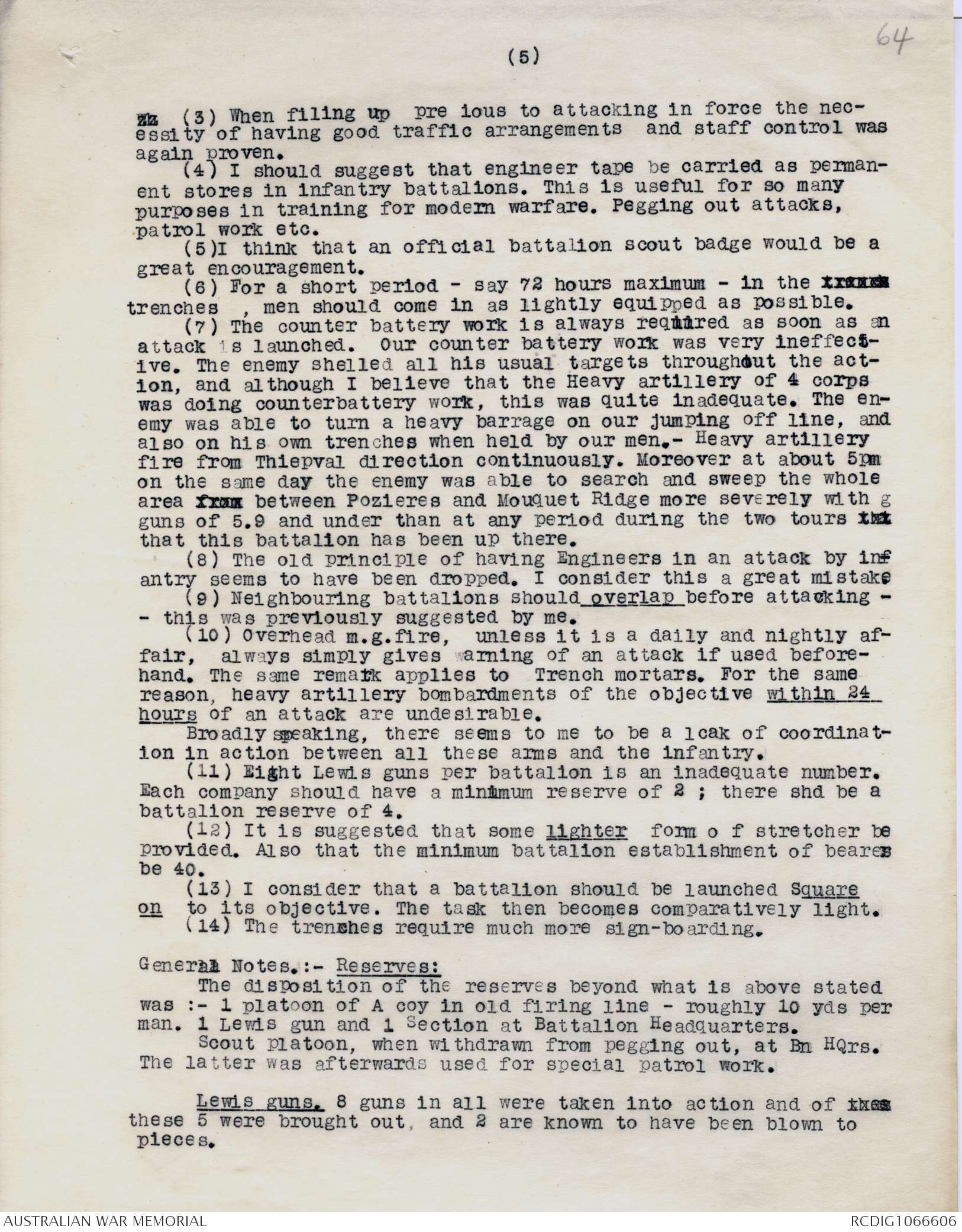
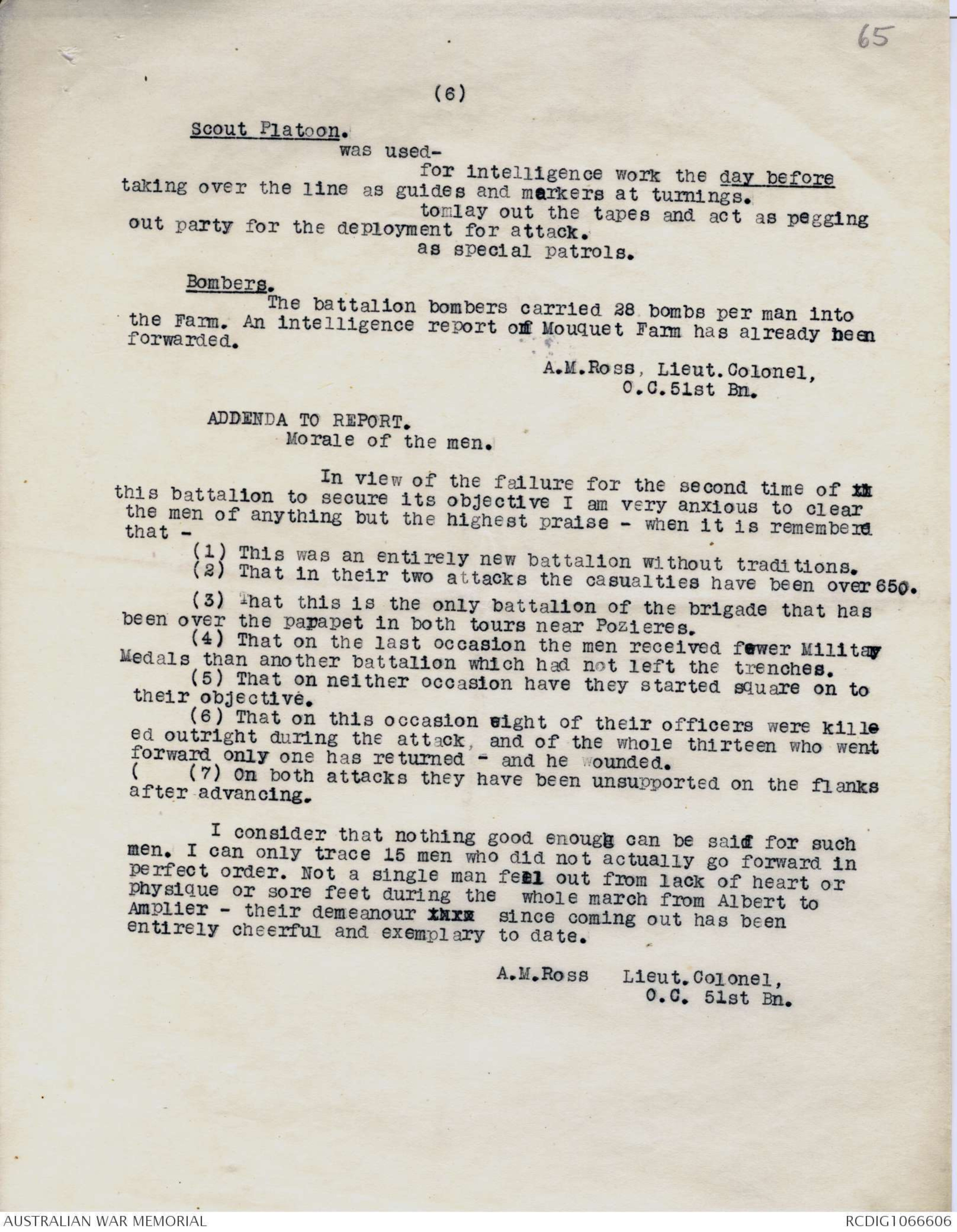
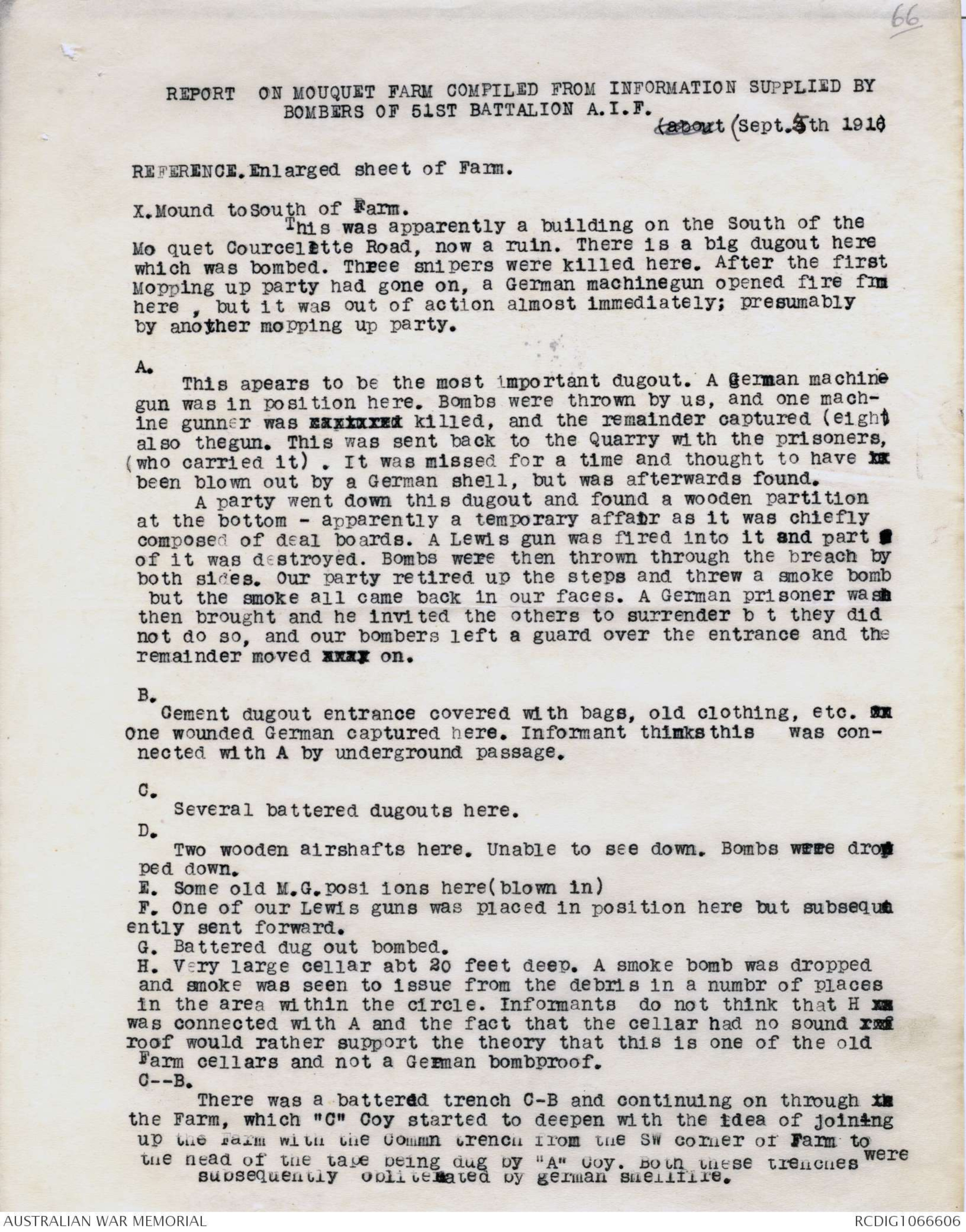
48 Bn
57
HN.
Aug5-7 Pozieres. Dave Twining.
48th went in on night ot 5/8. They were told to relieve
7 Bde in OG1 and 2. When they got into OG1 they could not find OG2
and the officer who was detailed to take the coy over to OG2 near
the Windmill would not take it over. Accordingly Cummin took over
that company over this officer's head, and took it forward to OG2.
He too could not find it but went over it and led his coy some way
out to the N. of the windmill. Dave Twining, who was a sergeant of
the battalion scouts, went out near the Windmill. He too tried to
find OG2 but could not, but he settled out a little to the NE of the
Windmill - OG2 ran West of it. Twining had at that time, I think,
30 men.
On Aug 6th the Germans used to come out from the direction
of the main road apparently stretcher bearing, and parties of
them tried to come within 20 yards of our line. The line was pretty
thin through German shellfire - all the time he was there Twining did
not hear more than a few rifle shots. T.wanted to prevent the Germans
from seeing how thin our line out there was, and he accordingly
was very anxious that these Germans should not come too near. At that
time it was the custom to let the Germans come pretty well where
they wanted if stretcher bearing. But one pair came out towards them
whom he was particularly desirous to keep away, and he warned them
off. They would not go, and so he shot one of the two. The man dropped
his stretcher and out of it fell a bag - not a wounded man. The
other German ran away. These Germans were certainly observing our
position. (Linas I believe once did the same thing for us. He was a
16th man and some of them were not, I fancy over-particular.)
The German shellfire caught our line in OG2 as well as in
OG1, and it lost very heavily. Cummin had to withdraw his company to
where ,or about where, OG2 was. Glasfurd had ordered Leane to hold
his line with three companies, and Leane must have had one man per
yard in OG2 . Even so he disobeyed orders and kept the third company
back in reserve. He and Glasfurd quarrelled over these orders and
never really made it up. The German line was about 100 yds in front
of Twining. T.could see the spire and roofs of Courcelette but
not the bottom of the houses or the ground.
On the morning of Aug7 the German shelling increased
very greatly. Leane had some pigeons with him and sent back word
that a counterattack was coming. A barrage was put down by the Lahor
artillery. Twining also had sent a messenger to Leane but his messenger
was killed. Twining only had about 3 unwounded men with him.
Presently, after dawn, there jumped out in front of him a machinegun
crew of Germans, coming straight for his post. Then along the front
of the 48th out came a line of Germans very thick. Just at that moment
down came our barrage and one of the first shells wiped out the
machinegun crew which was leading. As the Germans came forward the
barrage came upon them tremendously heavy, and Twining does not think
58
2.
that more than 60 Germans can have got through it. (* For German order see 48 Bn History*) They did not
affect his front but pushed on into OG2 and I think OG1, a little
north of T. just on the left sector of the 48th. They captured
an officer named Carter, who was not thought a great deal of, and
a certain number of men - the 48th had suffered very terribly by
shellfire - entirely by shellfire. They did not capture Hartley
who was a splendid officer (and I think was killed later). Twining
got some reverse fire onto these Germans in OG1.
Twinings few -2 or 3 then - could have done nothing
had the Germans come over them. He burnt a map which Leane had
given him of the bposition - just a map of the front.
When T.came out he found a splendid sap dug apparently
by the pioneers leading from OG1 to Tramway trench - it gave complete
cover, shoulder high.
Twining thinks that the 48th and 4th Divn were not
so much affected by Pozieres, or even Bullecourt (which knocked them
down for a day and just made them savage and keen to get back) as
by Passchendaele. They came out from Ypres at their lowest, he
says.
Dollery thinks the 12th came out lowest from
Bullecourt.
59
COPY.
20 BN
Pozieres 22/8/16
France,
9th September, 1916.
Mrs. T. H. Richards,
"Southmoor,"
VAUCLUSE, N.S.W.
Dear Madam,
All the officers of the Battalion wish me to
tender you their sympathy in the loss of your son.
He was the admiration of us all, and those who
knew him more intimately loved him. Since he returned to the
Battalion in July we have been very closely associated with
each other. One cannot speak too highly of his splendid
behavious during the strenuous days of July 25 to August 6.
For days he had little or no sleep, we were all so busy, but was
always smiling and cheerful. After leaving the line for a rest
we shared the same room for ten days or so, and it was then we
talked of the days we had just passed through. The strain had
told on him and his nights for some time were very restless - he
was always going through it again in his dreams, but this gradually
wore off and when we went into the same line on night of August
21st. he was feeling quite himself again. On August 22 your son
had been getting some valuable information in reference to the
German line and was just stepping into our trench and was struck
by machine gun fire in both legs, one leg was very bad, both
bones being fractured at the knee, the other wound appeared to
be only a flesh wound; the wounds were attended to and he was
sent off to the 3rd Casualty C. Station where one leg was
immediately amputated, some four days after this the other leg
became septic and was also amputated. The day following the
last operation we came out of the line and saw your son, our
chaplain and other officers were with him each day. Lieut.
(now Capt.) MacCullum also visited him.
We were sent away by train on 5th September and on
arriving at our destination received a wire from the Hospital
saying he had passed away at 11.30 p.m. 5th September. His
Batman, Pte. Birchel was with him all the time and your other
son I had written to and have since wired him. I felt you may
like to know all that could be told of your gallant son's last
days and I trust I have not caused you further suffering. Capt.
Richards was a capable and brave soldier and his other qualities
it is quite unnecessary for me to mention to you, his mother.
You may not know who I am, but some years ago I met you at Miss
Glasson's home at Bathurst and am thus able to judge how great
the loss if you have sustained.
May God comfort you all in your sorrow.
Yours sincerely
(SGD.) HAROLD PAUL.
60
51st Battalion A.I.F.
Report on operations at Mouquet Farm, 1/4 September,1916.
"B" Coy scouts and an advanced portion of Bn Headquarters left
Brickfields 6.30 p.m. 1/9/16 for the purpose of relieving 47th Bn
in Mouquet Farm sector. Three L.M.Guns accompanied this party. The
relief commenced midnight 1/2 Sept. "B" Coy xxxxx was complete
by 3am and remainder by 5am. The frontage taken over was R33 b 55
- Quarry a77- a81. Bn Hdqrs was established near R34 c 51. The
remainder of the bn left Brickfield after afternoon meal for La
Boiselle at 4pm. Up till this hour reports received from B coy
and L.M.G.section showed situation quiet.. Shelling of saps on
line 55-Quarry-81 generally ineffective. Smoke bombs rifle grenades
flares and rockets were drawn and dum ed at Kay dump during
afternoon. No 3 platoon(ration platoon) under an officer took
rations and water to front line, took over stores at Kay Dump,
and placed a reserve of water there. Subsequently battalion
grenade officers issued grenades etc., to coys as they passed the
dump. Two sandbags were carried on the men, also 48 hours rations
(Iron). No messtins ,greatcoats, or blankets were carried. xxxxxx
Grenade Dump was formed at Quarry, 2 grenades per man were carried.
During the day the scout officer and his platoon made a xxxx
close reconnaissance of Mouquet Farm, took bearings, made arrangements
for guides and laying tapes. A starting parallel on the
line 55-77 was cut by the 47th Bn., and the approach saps improved
by them. Strong Point at 77 was relieved by an equal detachment
from 50th Bn. Detailed operation orders were conveyed to xx
the Bn at La Boiselle, and explained to all ranks by the officers
Formations adopted were as practised in training. The forward
movement of Bn was commenced from La Boiselle at 9 pm. The following
arramgements for communication were made from Battalion Hdqrs-runners
and two signal wires back to Gibraltar. Runners forward x
to Quarry, with a relay station (Runner) at 33c77. Pigeons
arrived at 3pm. Liaison officer Lahore Divisional Artillery was a
at Bn Hdqrs and remained there throughout. Zero timeand final
instructions and synchronisation of watches was given to Coys
at Kays Dump on passing in. The head of "D" Company reached KDump
and entrance to Kays trench at 10.15.pm, Companies then passed in
on to the sap. Tail of battalion passed in at 11pm. Casualties up
to entering sap- one man severely wounded. The follg Commn was
established with flank Bns during the day.
(1) Firing line Coy
52nd Bn near point 48. (2) By runner with 13th Bn Cheshire Regt
400 yds west of Point 81. Runner reported to Bn Hdqrs at 3pm.
All wounded clear of firing line by 9am. Total casualties
1 k. 14 w., up to 10 am. R.M.O.and A.A.M.C details at Dressing
station near Bn Hdqurs. One section L.T.M.B. in position near
Quarry, with targets at about 54. Wires held well throughout the
day. At 11 pm situation normal. Battalion deployed ready fr attack
at 1.30am. in seven waves - B and D coys in two waves; bombers
and C coy in two waves; Last three - mopping up parties in
waves 40 yds interval.
Old firing line held thus: Post 81 Bomb Coy team. L.G.Team.
Ooint 77 held by 50th Bn. Total casualties during operation -
3 wounded. Deployment was made (reference map F.De Mouquet) R33.
55-pt 77. The central guiding tape was laid onto the objective
61
(2)
bearing 22 degrees from the Quarry. Pegging out was done by
Scout officer and platoon. Filtering out was commenced at l1pm
The order of coys was - B.D.C.A. and the formation was that of
6 waves each coy of 2 waves 50 yards apart and an extension of
2 to 3 yards, 1st wave consisting of 3 platoons, 2nd wave Hdqr
Bombers, L.G.secti n, 4th platoon carrying picks and shovels.
The 4th Coy was as follows - 2 platoons with picks and
shovels were digging communicatn sap forward from firing line,
one platoon garrisoning firing line with its L.G.Section and Hd-Qrs.,
one platoon on ration and water carrying. The whole bn was
in position to attack by 3am. There were no casualties during
that operation or previous to the assault.
Operation orders and Barrge map- see Bde order No16.
B COY:----- 3 platoons------(at 2 to 3 yds.)-----
50 yds
----H. Q., bombers,L.M.G. 4th platoon(picks etc.)---
50 yds
D COY ( same )
50 yds
50 yds
C Coy BBBB ( same )
50 yds
A Coy. 2 plat -oons
digging
saps
to
firing
line
One Platoon garrisoning line
One plat
-oon
carry
-ing
rati-
ons
The Action.
The barrage was perfect, and the waves followed up closely. The
two leading coys pushed forward with little difficulty on the
line 42-12 as ordered. 3rd line (C Coy and bn Grenadiers) who
formed the Battalion mopping up party, at once began clearing up
the Mound,farm, and dugouts. (for description of the Farm see
Intelligence officers report) Eventually 60 prisoners were captured,
3 dugouts were cleared out, and 2 m.gs were destroyed, one deliberately xxx ---
one from shell fire after capture. Machineguns
are fired from the dugout entrances, 10 lb bombs and rifle grenades
also. These openings are very difficult to discover. C Coy
commenced to dig in the support line at the Farm and dig back tot
the firing line to meet A coy sap. Touch was obtained on the
62
(3)
Eastern side of the farm with a few men of the 52nd bn, but touch
was never gained with the firing line and 52nd Bn. The latter
battalions left hand coy apparently lost direction and shortly
retired, thus opening the way for the enemy to come in from a
North easterly direction on our right flank. Enemy barraged all
our support lines and communication trenches at 8.30 am. and opened
a very heavy bombardment with xxxxx 9.2 shells on the f
Farm itself. There was much sniping and m.g. fire from all directions,
shell loles etc. This combined with enemys threat on bot
both flanks caused the firing line to ask for support which C coy
sent up in the form of 50 men. The heavy shelling and rifle
fire soon told on the mopping up parties and the Farm became
untenable. Finally it had to be evacuated by the remains of C Coy
and grenadiers at 10.30 am. The remains of B and D coys then
became isolated.
The isolation of the front line is to be accounted for
in the following manner.
1) There is not the slightest doubt that the advance was
on the true line and reached the objective ordered, namely
about 200 yds past the Farm-mound and overlapping point 42.
But no troops of the 52nd bn were ever on the line 73 to 42 to join
hands with this battalion.
(2) The enemys shelling and some
of our own was very severe
about point 42 and the casualties on the right of the front line
were heavy and consequently reduced the chances of linking up.
(3) Of the 2 platoons of the 52nd Bn which were supposed
to join up at the farm (having started on the line 33B48-87??DC)
only one N.C.O and abt 30 men arrived. Those helped our support
line at the North east shoulder of the Farm Mound and bldgs, and
subsequently they were ordered forward at about 8 am to look for
the 52nd Bn firing line east of point 42, but were never seen
again. The enemy on the exposed flank were then coming on strongly
and so -
(4) I was offered and accepted a company of the 50th bn. I
requested that xxxxxx the company might pass up on the line
33b 48-87 B G ??or 27) and act as a counterattack and fill the
line between near 73 and 42. This company never went, but stayed
near 55, subsequently joining my command in the evening.
5) Shelling made it impossible to sap backward communications
though this was attempted by a platoon.
Messages timed up to 8 am were received at Bn Headquarters
from front line. All their messages state that the two coys
were still hanging on in the old German trench near 42. They were
being bombedfrom towards 27D73 and 27D14 and sniped all round. a
At about 7.30 aircraft came over asking for flares - there were
then plenty of men near 42 (I believe that the aeroplanes reported
this) additional flareswere sent up to the advanced line, but
it is doubtful whetherthey ever arrived.
Communications between the front and the Farm were finally
broken about between 8.30 and 9am by parties of the enemy coming i
in on the right and also up from near point 12.At this time the
enemy were coming on strongly and the O.C. "C" Coy at the Farm was
unable to hold on owing to severe shell fire. He did not retire
until there were left only 2 officers and 30 men out of a mopping
up party of nearly 200. The Farm was evacuated at 9.30am. The ori
original firing line 55-Quarry-77 was then held by the remains of
63
(4)
3 Platoons of "A" coy and a few details of "C" and other coys and
50 men of the 50th Bn. In addition to these there were 4 Vickers
guns in the line and the guns at strong points 81 and 77.
The total prisoners captured amounted to 80. Two m.gs
were taken, one on the Farm - the other was brought back but
destroyed by shell fire near our lines (this afterwards turned
out to be wrong - the gun was found).
The approximate number of rounds fired during the period
2nd - 4th Sept, was:-
(1) Rifles 40=000 rounds.
(2) Lewis Guns 5,000 rounds.
(3) Bombs 1,800 rounds.
During the actual attack a length of communication trench
about 200 yds of backward communication trench of about 3 feet
deep through shellholes was constructed.
Supplies.
(1) The supply of rations and water was worked by 1
Platoon under an officer and worked well.
(2) The supply of ammunition bombs etc., flares at
Kaye's Dump and as arranged by Brigade was excellent. Wounded
were evacuated successfully. The enemy allowed us to work under
flag for about one hour every morning and sometimes for a longer
\period. The evacuation, once the firing line was cleared was very
rapid. The method of having very advanced dressing stations is r
really the best, provided that they are solid dugouts. These
should be reserved solely for stretcher cases.
Communications are still very bad, the saps in the whole
area being repeatedly blown in. The wires held very well during
the period between xxxxxx Bn H. Qrs and the advanced signal
station. All communications forward from Bn H.Qrs were by Runner-Relays
being established at about every 500 yds. During the deployment
all saps were kept clear and all turnings marked by
scouts of the scout platoon. The number of prisoners taken and
for which receipts were obtained by this battalion was 58. In
addition to this many were hit in course of being brought in,
and som declined to come in when under fire. It is under exaggeration
to say that at least 80 prisoners were taken. Over 70
Germans were killed in the Farm ruins alone, and probably many
more in the dugouts.
SUGGESTIONS, TACTICAL LESSONS, ETC.
(1) The communications are still very bad. The difficulty
of getting a really good jump-off are great. The remedy is
to have pioneers and engineers continuously repairing communication
saps. It is obvious to the most impractical that there
1 Pioneer battalion to every infantry brigade - I only saw the
Pioneers once between the 2nd and 4th Sept, and they were carrying
rations and water! There seemed to be little attempt at
drainage.
(2) A series of waves in an attack is essential.- great
depth. The German is sceure in his dugout during the barrage an
and he comes up with his m.gs as soon as he feels the lift pass
over. The only way to catch him is by some wave coming right on
to him and I am inclined to think that our attack under barrage
these days should be made in QUICK TIME THROUGHOUT.
64
(5)xx (3) When filing up previous to attacking in
force the necessity
of having good traffic arrangements, and staff control was
again proven.
(4) I should suggest that engineer tape be carried as permanent
stores in infantry battalions. This is useful for so many
purposes in training for modern warfare. Pegging out attacks,
patrol work etc.
(5)I think that an official battalion scout badge would be a
great encouragement.
(6) For a short period - say 72 hours maximum - in the xxxx
trenches, men should come in as lightly equipped as possible.
(7) The counter battery work is always required as soon as an
attack is launched. Our counter battery work was very ineffective.
The enemy shelled all his usual targets throughout the action,
and although I believe that the Heavy artillery of 4 corps
was doing counterbattery work, this was quite inadequate. The enemy
was able to turn a heavy barrage on our jumping off line, and
also on his own trenches when held by our men.- Heavy artillery
fire from Thiepval direction continuously. Moreover at about 5pm
on the same day the enemy was able to search and sweep the whole
area from between Pozieres and Mouquet Ridge more severely with g
guns of 5.9 and under than at any period during the two tours tha
that this battalion has been up there.
(8) The old principle of having Engineers in an attack by
infantry seems to have been dropped. I consider this a great mistake
(9) Neighbouring battalions should overlap before attacking -
this was previously suggested by me.
(10) Overhead m.g.fire, unless it is a daily and nightly affair,
always simply gives warning of an attack if used beforehand.
The same remark applies to Trench mortars. For the same
reason, heavy artillery bombardments of the objective within 24 hours
of an attack are undesirable.
Broadly speaking, there seems to me to be a lcak of coordination
in action between all these arms and the infantry.
(11) Eight Lewis guns per battalion is an inadequate number.
Each company should have a minimum reserve of 2 ; there shd be a
battalion reserve of 4.
(12) It is suggested that some lighter form of stretcher be
provided. Also that the minimum battalion establishment of bearers
be 40.
(13) I consider that a battalion should be launched Square
on to its objective. The task then becomes comparatively light.
(14) The trenches require much more sign-boarding.
General Notes.:- Reserves:
The disposition of the reserves beyond what is above stated
was :- 1 platoon of A coy in old firing line - roughly 10 yds per
man. 1 Lewis gun and 1 Section at Battalion Headquarters.
Scout platoon, when withdrawn from pegging out, at Bn HQrs.
The latter was afterwards used for special patrol work.
Lewis guns. 8 guns in all were taken into action and of these
these 5 were brought out, and 2 are known to have been blown to
pieces.
65
(6)
Scout Platoon.
was used-
for intelligence work the day before
taking over the line as guides and markers at turnings.
tomlay out the tapes and act as pegging
out party for the deployment for attack.
as special patrols.
Bombers.
The battalion bombers carried 28 bombs per man into
the Farm. An intelligence report of Mouquet Farm has already heen
forwarded.
A.M.Ross, Lieut. Colonel,
O.C.51st Bn.
ADDENDA TO REPORT.
Morale of the men.
In view of the failure for the second time of th
this battalion to secure its objective I am very anxious to clear
the men of anything but the highest praise - when it is remembered
that -
(1) This was an entirely new battalion without traditions.
(2) That in their two attacks the casualties have been over 650.
(3) That this is the only battalion of the brigade that has
been over the parapet in both tours near Pozieres.
(4) That on the last occasion the men received fewer Military
Medals than another battalion which had not left the trenches.
(5) That on neither occasion have they started square on to
their objective.
(6) That on this occasion eight of their officers were killed
outright during the attack, and of the whole thirteen who went
forward only one has returned - and he wounded.
(7) On both attacks they have been unsupported on the flanks
after advancing.
I consider that nothing good enough can be said for such
men. I can only trace 15 men who did not actually go forward in
perfect order. Not a single man fell out from lack of heart or
physique or sore feet during the whole march from Albert to
Amplier - their demeanour thro since coming out has been
entirely cheerful and exemplary to date.
A.M.Ross Lieut. Colonel,
O.C. 51st Bn.
66
REPORT ON MOUQUET FARM COMPILED FROM INFORMATION SUPPLIED BY
BOMBERS OF 51ST BATTALION A.I.F.about (Sept.5th 1916
REFERENCE.Enlarged sheet of Farm.
X.Mound toSouth of Farm.
This was apparently a building on the South of the
Mo quet Courcelette Road, now a ruin. There is a big dugout here
which was bombed. Three snipers were killed here. After the first
Mopping up party had gone on, a German machinegun opened fire frm
here, but it was out of action almost immediately; presumably
by another mopping up party.
A.
This apears to be the most important dugout. A German machine
gun was in position here. Bombs were thrown by us, and one machine
gunner was captured killed, and the remainder captured (eight
also thegun. This was sent back to the Quarry with the prisoners,
(who carried it). It was missed for a time and thought to have xx
been blown out by a German shell, but was afterwards found.
A party went down this dugout and found a wooden partition
at the bottom - apparently a temporary affair as it was chiefly
composed of deal boards. A Lewis gun was fired into it and part xx
of it was destroyed. Bombs were then thrown through the breach by
both sides. Our party retired up the steps and threw a smoke bomb
but the smoke all came back in our faces. A German prisoner wasb
then brought and he invited the others to surrender b t they did
not do so, and our bombers left a guard over the entrance and the
remainder moved xxxx on.
B.
Cement dugout entrance covered with bags, old clothing, etc. xx
One wounded German captured here. Informant thinks this was connected
with A by underground passage.
C.
Several battered dugouts here.
D.
Two wooden airshafts here. Unable to see down. Bombs were dropped
down.
E. Some old M.G.posi ions here (blown in)
F. One of our Lewis guns was placed in position here but subsequently
sent forward.
G. Battered dug out bombed.
H. Very large cellar abt 20 feet deep. A smoke bomb was dropped
and smoke was seen to issue from the debris in a numbr of places
in the area within the circle. Informants do not think that H xx
was connected with A and the fact that the cellar had no sound rxx
roof would rather support the theory that this is one of the old
Farm cellars and not a German bombproof.
C--B.
There was a battered trench C-B and continuing on through xx
the Farm, which "C" Coy started to deepen with the idea of joining
up the Farm with the Commn trench from the SW corner of Farm to
the head of the tape being dug by "A" Coy. Both these trenches were
subsequently obliterated by german shellfire.
 Sam scott
Sam scottThis transcription item is now locked to you for editing. To release the lock either Save your changes or Cancel.
This lock will be automatically released after 60 minutes of inactivity.